Intel Haswell Low Power CPU Review: Core i3-4130T, i5-4570S and i7-4790S Tested
by Ian Cutress on December 11, 2014 10:00 AM ESTCPU Benchmarks
The dynamics of CPU Turbo modes, both Intel and AMD, can cause concern during environments with a variable threaded workload. There is also an added issue of the motherboard remaining consistent, depending on how the motherboard manufacturer wants to add in their own boosting technologies over the ones that Intel would prefer they used. In order to remain consistent, we implement an OS-level unique high performance mode on all the CPUs we test which should override any motherboard manufacturer performance mode.
FastStone Image Viewer 4.9
FastStone is the program I use to perform quick or bulk actions on images, such as resizing, adjusting for color and cropping. In our test we take a series of 170 images in various sizes and formats and convert them all into 640x480 .gif files, maintaining the aspect ratio. FastStone does not use multithreading for this test, and results are given in seconds.
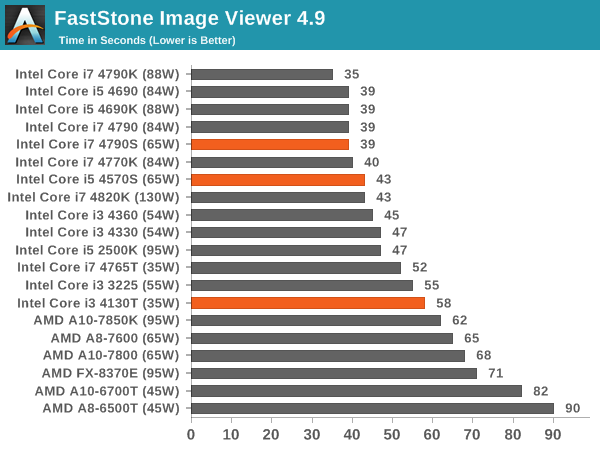
In single threaded mode these CPUs are designed to act like their non-S counterparts, except for the T which takes a bigger adjustment in the FastStone benchmark.
Dolphin Benchmark: link
Many emulators are often bound by single thread CPU performance, and general reports tended to suggest that Haswell provided a significant boost to emulator performance. This benchmark runs a Wii program that raytraces a complex 3D scene inside the Dolphin Wii emulator. Performance on this benchmark is a good proxy of the speed of Dolphin CPU emulation, which is an intensive single core task using most aspects of a CPU. Results are given in minutes, where the Wii itself scores 17.53 minutes.
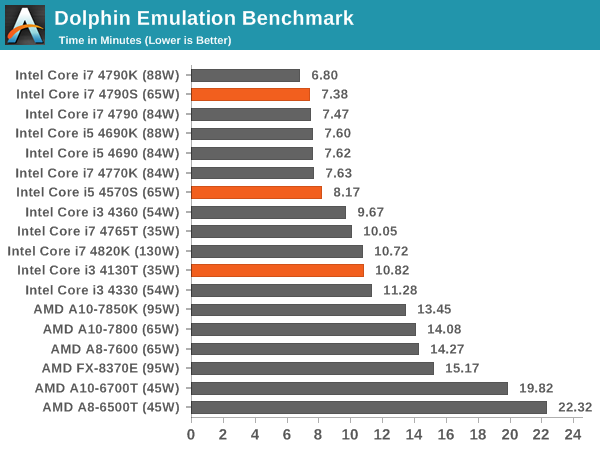
Dolphin is also single threaded, where the i7-S CPU performs on par with its non-S counterparts. The i3-T is more along the other i3 CPU we have tested.
HandBrake v0.9.9: link
For HandBrake, we take two videos (a 2h20 640x266 DVD rip and a 10min double UHD 3840x4320 animation short) and convert them to x264 format in an MP4 container. Results are given in terms of the frames per second processed, and HandBrake uses as many threads as possible.
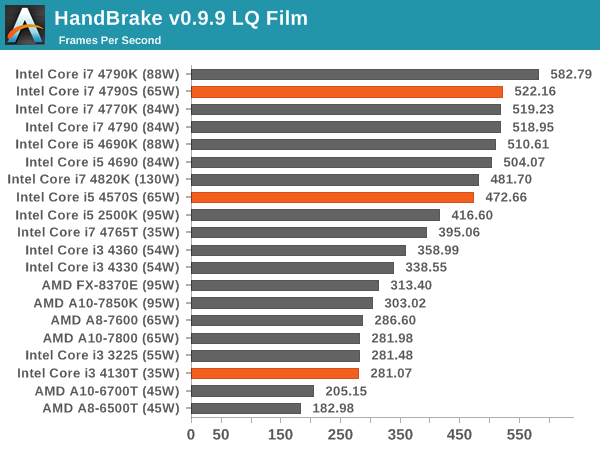
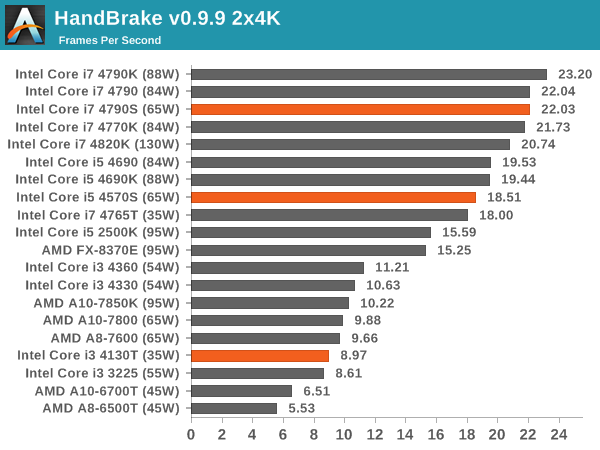
WinRAR 5.0.1: link
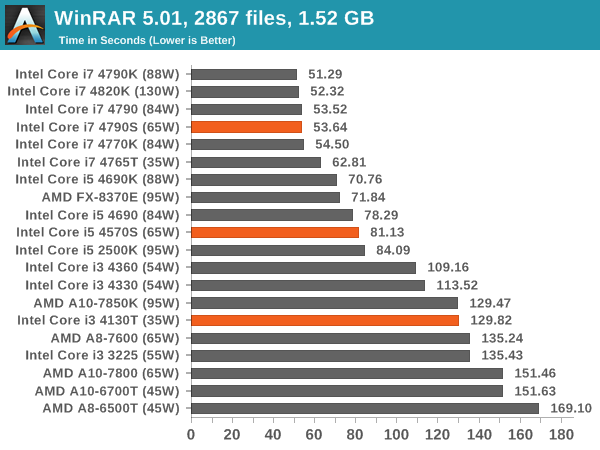
WinRAR exposes some of the variable multithreaded results, here showing the i3-T is a bit down on the non-T, but the S models are on par again.
3D Particle Movement
3DPM is a self-penned benchmark, taking basic 3D movement algorithms used in Brownian Motion simulations and testing them for speed. High floating point performance, MHz and IPC wins in the single thread version, whereas the multithread version has to handle the threads and loves more cores.

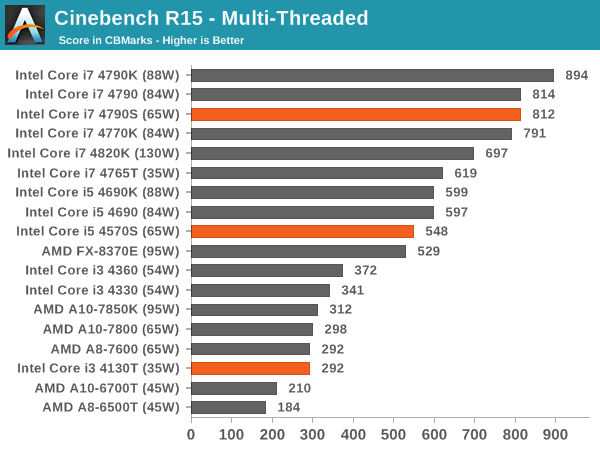
Surprisingly our i7-S CPU seems too perform as well as the non-S CPU.
Web Benchmarks
On the lower end processors, general usability is a big factor of experience, especially as we move into the HTML5 era of web browsing. For our web benchmarks, we take four well known tests with Chrome 35 as a consistent browser.
Sunspider 1.0.2
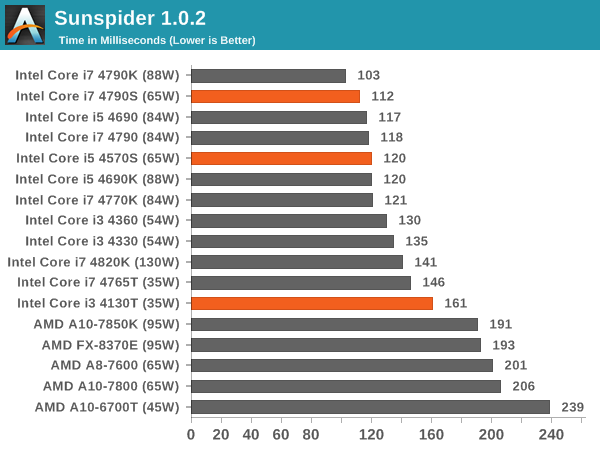
Mozilla Kraken 1.1
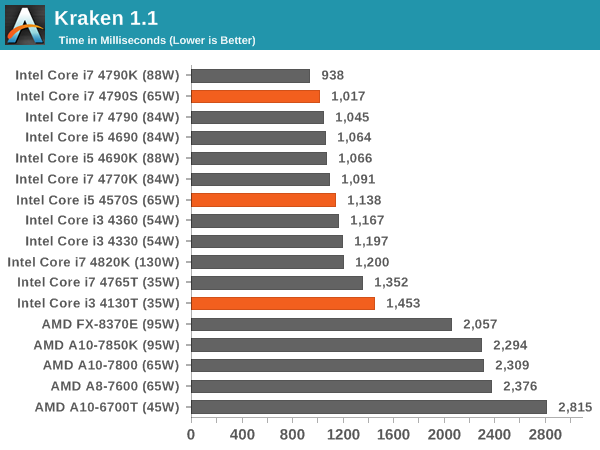
WebXPRT
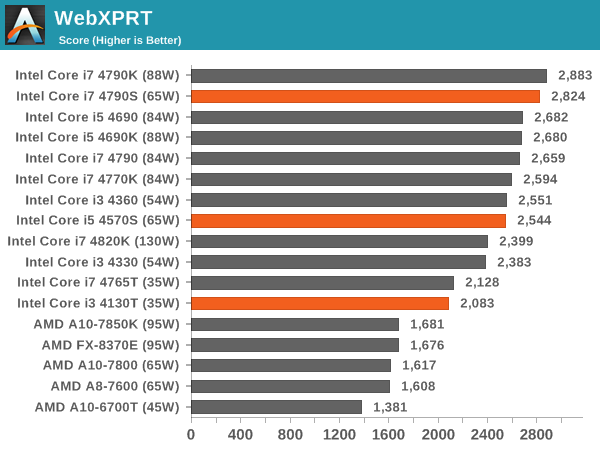
Google Octane v2
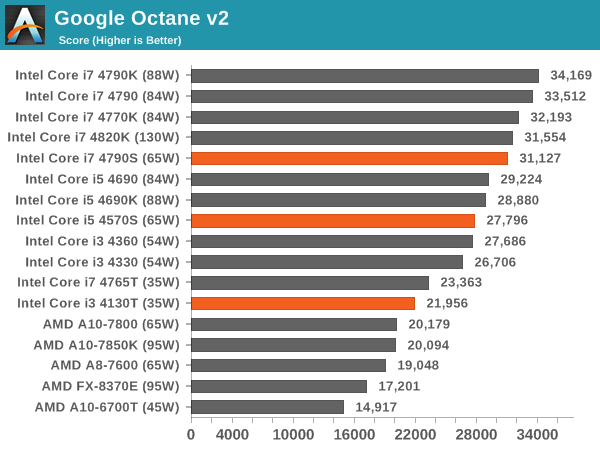










76 Comments
View All Comments
eanazag - Thursday, December 11, 2014 - link
That would directed at Ryan Smith and maybe jarred Walton for the mobile side of the equation. I suspect that the mobile side is unaffected at the moment.The only card that is well supported by all the new features in Omega is the R9 285 (Tonga). The R9 290 and 290X make a decent showing but are missing the 4K virtual resolution support.
chekk - Thursday, December 11, 2014 - link
Based on some other reviews, I was starting to think Anandtech had switched back to separate power consumption idle and load numbers, but here we go again. Please stop.The audience here is enthusiasts and enthusiasts want the complete picture.
DiHydro - Thursday, December 11, 2014 - link
I agree, if I have a server that is idle most of it's life, I want to know how many watts it is drawing at idle. On the other hand, if it is running 100% 24/7 then I want to see if a higher TDP, better performing CPU will be cost effective over a cheaper lower TDP part that might run a task longer.alacard - Thursday, December 11, 2014 - link
Xbitlabs did an excellent write up on the 4670S and T variants. Idle results for those can be found here: http://www.xbitlabs.com/articles/cpu/display/core-...Ultimately extremely disappointing results. Intel couldn't even be bothered to do the bare minimun and bin these chips for better perf/watt. Pathetic.
TiGr1982 - Thursday, December 11, 2014 - link
Captain Obvious tells us all, that Intel has a very weak competition on the x86 CPU front in all the recent years (I would say, right from the launch of Sandy Bridge LGA1155 almost 4 years ago). So, they make big money "for free" (in a sense that it's an easy money for them) all these years and don't have to bother about such peculiarities as better perf/watt...Khenglish - Thursday, December 11, 2014 - link
That xbitlabs review is very good and what I would have liked to see done here.Yeah bad results. I was hoping that these new parts meant that intel improved haswell's power efficiency, but in reality they just lowered the TDP.
smilingcrow - Thursday, December 11, 2014 - link
This feels like almost a completely wasted review, a sort of Seinfeld review; a review about nothing.Most things you can surmise about these S chips as many things scale linearly so it would have been good to have seen a much better focus on power consumption.
The unanswered question is whether these chips use different voltages than the stock chips and also a lack of hard power data; the delta data is not enough.
Also what did you use to load the cores?
It says AVX but what application and is AVX a good example to use as how many applications use it?
I’d like to have seen a focus on different CPU loads to determine the different characteristics of these S chips; INT, FP, AVX.
So rather than the multitude of redundant data that can deduced from scaling of frequency why not something focused and new!
What a wasted opportunity and a poorly thought out review.
theKai007 - Thursday, December 11, 2014 - link
Intel announced the Intel IoT Platform, a reference model end-to-end designed to unify ans simplify connectivity and security for the Internet of Things. http://bit.ly/1yCMSnBname99 - Thursday, December 11, 2014 - link
Look at the partners.Looks more like a enterprise software "solution" to acquire/store/extract data from than actual hardware or anything of interest to normal folks.
As long as Intel's HW story in that space is Quark, forget it...
xeizo - Thursday, December 11, 2014 - link
Right on spot, I use a 4570S in my Linux home server. But as an enthusiast I did some bclk(couldn't resist it) to 106.4 so that it Turbo:s to 3.83GHz and multithreadsx4 to 3.4GHz ;-) Anyway, it feels very fast running Linux. I couldn't have used a K-processor as I wouldn't be able to resist maximum clock it, no power saving server ...Gaming is done on a 4.8GHz 2600K, it doesn't look like a need to replace it anytime soon. Unless Skylake surprises us all.
Nice job informing about those lower power cpus, saves us time from undervolting and just draws less power from day one.